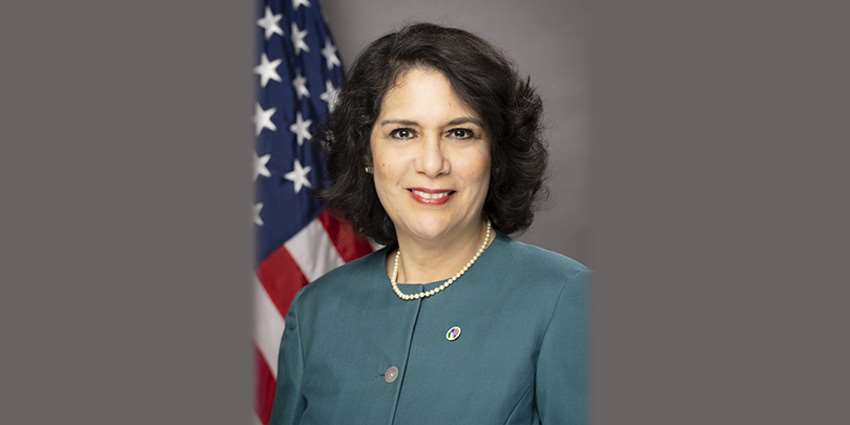This article was originally published on January 20, 2022, by Texas+Water.
In the January 2022 issue of Texas+Water, Texas+Water Editor-in-Chief Todd Votteler, Ph.D., interviewed Maria-Elena Giner, Ph.D., U.S. commissioner of the International Boundary and Water Commission for United States and Mexico (IBWC).
President Joe Biden appointed Giner to serve as the U.S. commissioner of the IBWC in August 2021. Giner, the second woman and first Latina to hold the post, previously served as general manager of the Border Environment Cooperation Commission (BECC), an institution that developed environmental infrastructure along the U.S.-Mexico border in association with the North American Development Bank. During her tenure at the BECC, she focused on policies that addressed U.S.-Mexico cooperation on water, energy and climate change.
Giner’s education includes a Bachelor of Science in civil engineering from Loyola Marymount University, a Master of Business Administration from the University of Texas at El Paso and a doctorate in public policy from the University of Texas at Austin. She is also a registered professional engineer, first-generation college graduate and daughter of an immigrant. Giner is from the border region and attended Loretto Academy High School in El Paso, Texas. She is bicultural and bilingual.
What is the International Boundary and Water Commission (IBWC)?
The International Boundary and Water Commission (IBWC) is a federal agency — binationally operated by the United States and Mexico. The U.S. Section of the IBWC, the USIBWC, is responsible for applying the boundary and water treaties between the two countries and settling differences that arise in their application. Our duties include operating and maintaining flood control levees, international storage reservoirs, diversion dams, wastewater treatment plants and boundary monuments at various locations on the U.S.-Mexico border.
As the new commissioner, what are your top priorities for the USIBWC?
My top priorities are what I call the 3 Ps: personnel, projects and policies.
Personnel: I want to ensure there is sufficient staffing and tools needed to operate and maintain our system. This includes filling positions, increasing training, improving technology and having adequate facilities and equipment.
Projects: There are many pressing issues related to aging infrastructure, such as at Amistad Dam, the Rio Grande levee system and transboundary flows of water pollution. For existing infrastructure, I intend to complete an asset management plan that evaluates age, condition and impact. This will assist in prioritizing funding needed and lead to the development of an asset management system that will support a maintenance program. New infrastructure will be added in Nogales, Arizona and San Diego, California, which will address transboundary flows associated with pollution. Finally, pollution at the New River in California is an issue that will need to be addressed by working with local stakeholders to identify viable solutions.
Policies: My policy perspectives will focus on two primary issues, sanitation and water supply, both of which require cooperation with Mexico and our legislative, state and local stakeholders. First is developing a plan to ensure long-term sustainability of wastewater infrastructure in Mexico to mitigate issues with transboundary pollution associated with aging sanitation. This will include ensuring that sufficient funding is requested based on a methodological approach to maintain the necessary infrastructure. Second, I will focus on conservation efforts in the Colorado River and timely delivery of water in the Rio Grande through the creation of new water sources or water conservation efforts.
What do you consider to be the biggest challenge(s) facing Mexico and the United States over the next 20 years regarding the water resources that we share?
The biggest challenges I anticipate are aging infrastructure and water availability due to reduced runoff and temperature increases caused by climate change. The first challenge will require investment in maintaining our water related assets. The second challenge will require innovative solutions and cooperation with Mexico that will create new water sources and conserve existing ones. Addressing these challenges will be a cross-cutting effort integrated into my 3 Ps of personnel, projects and policies.
What aspect of your experience in water management do you consider to be the most valuable to you in your new role as commissioner?
I have lived in and worked with communities along the U.S.-Mexico border for over 25 years. In my previous experience as general manager of BECC, I led the development and financing of $9 billion in environmental infrastructure, including water, benefitting about a hundred communities and over 10 million residents. I worked with U.S. and Mexican federal and state agencies in California, Arizona, New Mexico, Texas and the six Mexican states. This experience has provided me the know-how to solicit and manage federal funding with demonstrated results and understand state and local challenges and processes related to water in both countries, as well as given me credibility with stakeholders at the federal, state, local and non-governmental level.
What are you looking forward to the most in your new role as commissioner?
I am excited about leveraging my experience, deep ties on both sides of the border and bilingual and bicultural heritage in my new role at the USIBWC. My vision for this organization is to ensure that our agency and its facilities are resilient and able to serve the needs of the region. With the support of staff and cooperation with Mexico, I look forward to advancing the mission of the USIBWC to improve the quality of life of our border residents.

